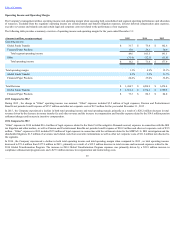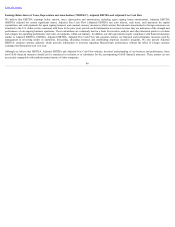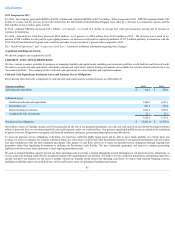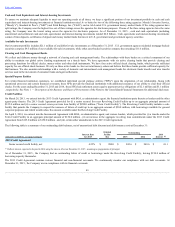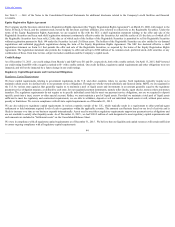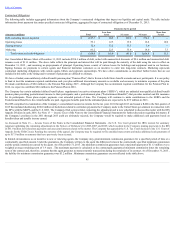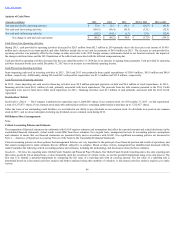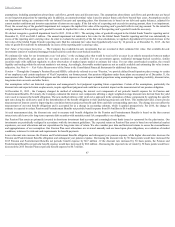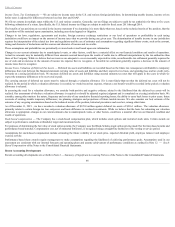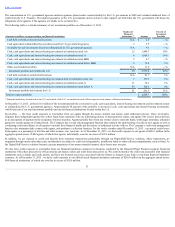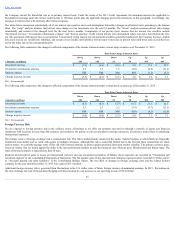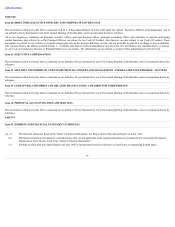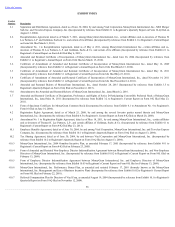MoneyGram 2015 Annual Report Download - page 49
Download and view the complete annual report
Please find page 49 of the 2015 MoneyGram annual report below. You can navigate through the pages in the report by either clicking on the pages listed below, or by using the keyword search tool below to find specific information within the annual report.
Table of Contents
IncomeTaxes,TaxContingencies— We are subject to income taxes in the U.S. and various foreign jurisdictions. In determining taxable income, income or loss
before taxes is adjusted for differences between local tax laws and GAAP.
We file tax returns in multiple states within the U.S. and various countries. Generally, our tax filings are subject to audit by tax authorities for three to five years
following submission of a return. Specifically, the U.S. federal income tax filings are subject to audit for fiscal years 2011 through 2014.
The benefits of tax positions are recorded in the income statement if we determine it is more-likely-than-not, based on the technical merits of the position, that the
tax position will be sustained upon examination, including any related appeals or litigation.
Changes in tax laws, regulations, agreements and treaties, foreign currency exchange restrictions or our level of operations or profitability in each taxing
jurisdiction could have an impact on the amount of income taxes that we provide during any given year. The determination of taxable income in any jurisdiction
requires the interpretation of the related tax laws and regulations and the use of estimates and assumptions regarding significant future events, such as the amount,
timing and character of deductions and the sources and character of income and tax credits.
These assumptions and probabilities are periodically reviewed and revised based upon new information.
Changes in our current estimates due to unanticipated events, or other factors, could have a material effect on our financial condition and results of operations.
Actual tax amounts may be materially different from amounts accrued based upon the results of audits due to different interpretations by the tax authorities than
those of the Company. While we believe that our reserves are adequate to cover reasonably expected tax risks, an unfavorable tax settlement generally requires the
use of cash and an increase in the amount of income tax expense that we recognize. A favorable tax settlement generally requires a decrease in the amount of
income taxes that we recognize.
IncomeTaxes,ValuationofDeferredTaxAssets— Deferred tax assets and liabilities are recorded based on the future tax consequences attributable to temporary
differences that exist between the financial statement carrying value of assets and liabilities and their respective tax basis, and operating loss and tax credit carry-
forwards on a taxing jurisdiction basis. We measure deferred tax assets and liabilities using enacted statutory tax rates that will apply in the years in which we
expect the temporary differences to be recovered or paid.
The carrying amount of deferred tax assets must be reduced through a valuation allowance if it is more-likely-than-not that the deferred tax asset will not be
realized. In the period in which a valuation allowance is recorded, we would record tax expense, whereas a tax benefit would be recorded in the period a valuation
allowance is released.
In assessing the need for a valuation allowance, we consider both positive and negative evidence related to the likelihood that the deferred tax assets will be
realized. Our assessment of whether a valuation allowance is required or should be adjusted requires judgment and is completed on a taxing jurisdiction basis. We
consider, among other matters: the nature, frequency and severity of any cumulative financial reporting losses; the ability to carry back losses to prior years; future
reversals of existing taxable temporary differences; tax planning strategies and projections of future taxable income. We also consider our best estimate of the
outcome of any on-going examinations based on the technical merits of the position, historical procedures and case law, among other items.
As of December 31, 2015 , we have recorded a valuation allowance of $125.8 million against deferred tax assets of $216.1 million . The valuation allowance
primarily relates to certain foreign tax loss carryovers and basis difference in revalued investments. While we believe that the basis for estimating our valuation
allowance is appropriate, changes in our current estimates due to unanticipated events, or other factors, could have a material effect on our financial condition and
results of operations.
Stock-based compensation — The Company has a stock-based compensation plan, which includes stock options and restricted stock units. Certain awards are
subject to performance conditions at threshold, target and maximum levels.
For purposes of determining the fair value of stock option awards, the Company uses the Black-Scholes single option pricing model for the time-based awards and
performance-based tranches. Compensation cost, net of estimated forfeitures, is recognized using a straight-line method over the vesting or service period.
Assumptions for stock-based compensation include estimating the future volatility of our stock price, expected dividend yield, employee turnover and employee
exercise activity.
Performance-based share awards require management to make assumptions regarding the likelihood of achieving performance goals. Assumptions used in our
assessment are consistent with our internal forecasts and operating plans and assume achievement of performance conditions as outlined in Note 12 — Stock-
BasedCompensationof the Notes to the Consolidated Financial Statements .
Recent Accounting Developments
Recent accounting developments are set forth in Note 2 — SummaryofSignificantAccountingPoliciesof the Notes to the Consolidated Financial Statements.
48



